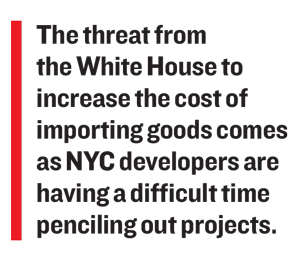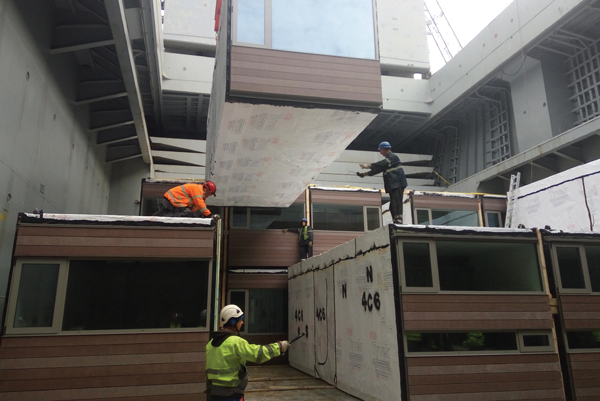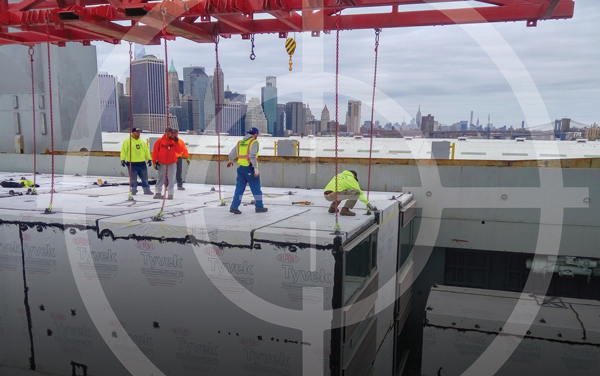From TRD New York: When Synapse Development needed insulated windows for its 34-unit rental development at 542 West 153rd Street, it found them on the other side of the Atlantic Ocean. The company signed a deal to buy the windows for the project — an environmentally “passive” structure known as Perch Harlem — from Schüco, a German company with a plant in Hungary.
Synapse’s CEO, Justin Palmer, said that despite the slightly more complicated logistics, the firm saved about 20 percent over what it would have paid for a comparable product made in the United States.
“We had a six-month lead time,” he said, explaining how the company made the purchase work. “You just have to plan for where you’re buying from.”
Two decades ago, getting specialized windows from Hungary would have been unheard of — or at least extremely rare. But in today’s global economy, buying construction materials from companies based in foreign countries has become the norm.
“There is definitely a globalization of our industry,” said Marc Weissbach of the national construction consulting firm Vidaris, which is headquartered in Manhattan.
Windows, steel beams, concrete, doors, floorings and entire curtain walls used in New York City skyscrapers are now regularly imported.
The trend of New York City developers and construction companies buying materials from foreign-based sources is not new.
“[It] started maybe 15 years ago, but it accelerated after the recession in 2008 because developers started to look at every element of development to reduce costs,” said Louis Coletti, president and CEO of the Building Trades Employers’ Association, which represents 27 trade-union contractors in the five boroughs.
But the practice could soon be in the crosshairs given the hardline stance that President Donald Trump has taken toward global trade since taking office — a position that helped buoy him to victory in the Rust Belt and other working-class areas of the country.
Arguing that the U.S.’ free-trade deals hurt manufacturing domestically, Trump is turning decades of bipartisan trade policy on its head.
In his first week in the White House, he announced plans to pull out of the Trans-Pacific Partnership, a 12-nation trade agreement negotiated by President Barack Obama, which was, among other things, designed to squelch the economic muscle of China.
 And last month, his new Treasury Secretary, Steven Mnuchin, caused a geopolitical stir when at a meeting of the G20 — an organization of 20 major economies — he refused to sign onto the group’s pledge to reject economic protectionism.
And last month, his new Treasury Secretary, Steven Mnuchin, caused a geopolitical stir when at a meeting of the G20 — an organization of 20 major economies — he refused to sign onto the group’s pledge to reject economic protectionism.
Experts say that if Trump is successful at implementing trade barriers on goods from China and Mexico — as he’s already threatened to do — or any other country, there could be a major trickle-down effect on construction materials in New York.
“We have a tremendous reliance in New York City and around the nation on the global supply chain, and anything that affects that supply chain has a very identifiable impact on project costs and schedules,” said attorney Barry LePatner, whose eponymous Manhattan-based firm specializes in construction law.
Synapse’s Palmer predicted that if Trump’s rhetoric becomes reality, there will be a shift toward local manufacturing of New York construction materials.
Having U.S. companies supply more building materials would “cut out the risk” when it comes to execution, logistics, currency fluctuation and international shipping, he said.
That, he added, would be a “win for any developer,” but it “depends on what actually gets implemented on policy.”
Going global
Estimating what percentage of New York City’s construction material comes from abroad is virtually impossible. For starters, there is no public clearinghouse that tracks the figures.
In addition, usage of materials varies between projects, and even U.S. suppliers use some materials from abroad.
But Richard Wood, the president and CEO of Plaza Construction, said the percentage of materials from overseas is steadily increasing.
And the threat from the White House to increase the cost of importing goods comes as New York City developers are having a difficult time penciling out their balance sheets to make projects work. That’s particularly true for high-end residential condos, where the market is softening.
And while construction costs leveled out in 2016 — rising only 4 percent, according to the New York Building Congress — New York City is still the priciest U.S. city to build in and one of the priciest in the world.
Developers are, not surprisingly, intent on getting the best deal possible for materials.
To get an idea of just how important the cost of materials is to developers, look no further than 45 Broad Street.

Construction workers assembling modules at the Pod Hotel, one of many NYC projects that’s purchased construction materials from abroad
When developer Robert Gladstone of Madison Equities announced a partnership with Chinese developer Gemdale Properties and Investment on the 1,100-foot-tall Financial District condo tower, he touted access to cheap materials as a benefit of the deal.
“We live in a global society; everything is a collaboration today,” Gladstone told the Wall Street Journal in June. “This allows [Madison] to buy materials from two submarkets and take advantage of the best materials, price and delivery.” Gladstone did not respond to a request for comment for this article.
While few developers have access to overseas materials through a joint-venture partner, many are trying to get their Chinese concrete fix.
That’s because material prices are on the rise.
According to the Bureau of Labor Statistics’ Producer Price Index for February, the price of domestically produced steel-mill products, concrete, cement and glass all rose over the last year, although modestly, with the exception of steel, which rose 15 percent.
In addition, Chinese officials announced last year that the country would roll back its steel production by 20 percent, prompting economists to predict that steel prices will continue to rise through 2020, according to an analysis by the Colorado-based firm General Steel Corporation.
Land prices, meanwhile, have been rising steadily in New York, putting more pressure on developers to find creative ways to make projects work financially.
The painful experience of the 2008 market downturn, when more than a few New York developments were lost to bankruptcy midconstruction, made developers more cost-conscious.
At the same time, the high-rise construction boom that kicked off in 2012 increased the demand for local materials and workers, pushing up their price. Between 2013 and 2015, average New York construction costs rose by about 5 percent per year and hit $550 per square foot in mid-2016 (more than triple the Berlin average).
But going abroad for materials is not just about saving money.
While suppliers in the U.S. are plentiful, the same is not true in many European countries, like Italy and Germany. As a result, many European suppliers have pushed to become more innovative to get a competitive edge.
While Synapse’s Palmer noted that the windows he bought were about 20 percent cheaper than what he could have purchased in the U.S., he said the main reason he chose a German supplier was that it had more experience making passive house windows.
“Numerous firms that we spoke to in the U.S. would have been making these style windows for the first time, which presented an execution risk that we were not willing to take at the time,” he said.
 Often, foreign suppliers have a reputation for quality. “Italian marble” has become a buzzword for luxury in new developments, and not because it’s cheap. But high-end Jacuzzis in über-luxury New York buildings aside, developers are using foreign suppliers for the basic materials they need to build the bones of their structures.
Often, foreign suppliers have a reputation for quality. “Italian marble” has become a buzzword for luxury in new developments, and not because it’s cheap. But high-end Jacuzzis in über-luxury New York buildings aside, developers are using foreign suppliers for the basic materials they need to build the bones of their structures.
Sometimes those developers have direct relationships with overseas suppliers, but more often they go through contractors or consultants. Either way, a lot of travel is involved.
“Folks do travel the world to purchase these things,” Vidaris’ Weissbach said. “Any given week, we have staff in some country inspecting facilities.”
Glass windows, cabinets and other valued-added materials often come from Europe. But more fundamental materials like steel often come from China. That, however, varies depending on fluctuations in the shipping costs.
When shipping — which largely depends on the price of oil — is cheap, it makes more sense to get materials from far away. Exchange rates and overcapacity in exporting countries can also have an impact.
“Right now we’re seeing a lot [of construction materials] from Europe because the euro is depressed,” Weissbach said.
New York, made in Poland
Sometimes it’s not just individual raw materials being imported — it’s whole chunks of a project.
The Pod Hotel in Williamsburg, for example, is made up of modules assembled in a factory in Poland. The shipping-container-sized building blocks are sent to the U.S. and then stacked together on-site.
CBRE’s Robert Barone, who advises the development team CB Developers and Ironstate Development on the project, said that while there were delays, the developers won favorable terms from the manufacturer, Polcom.
The Polish firm is also delivering modules for another project, the hotel group CitizenM’s 19-story, 300-room 189 Bowery. On both projects, Polcom worked with a local construction manager, SkyStone Group.
The Pod Hotel and 189 Bowery may be extreme examples, but other developers often buy entire HVAC systems or preassembled wall parts abroad, which reduces the workload on-site.
Apart from lower prices, assembling a building in a factory rather than 15 floors above a New York City sidewalk also tends to minimize errors and injuries.
“The quality control you get is typically greater than what you can get on-site,” said Julian Anderson of the global construction consultancy Rider Levett Bucknall, an adviser on the renovation of the Hôtel Plaza Athénée on the Upper East Side, among other projects.
Vidaris’ Weissbach said one of his clients recently bought prebuilt, 5-by-13-foot curtain-wall panels — which were 15 percent cheaper than having construction workers pull up walls — from a supplier in Turkey for a Midtown project.
“We did have to buy more aspirin to get [it] done, but the client ended up saving $5 million,” he said, noting that if the saving had only been 10 percent, he might not have recommended it.
Still, the risks of buying abroad are substantial.
If the wrong material is shipped or there are any defects, sending something back can easily set a project back months — which translates into financial losses for developers. And fixing those problems locally can also prove costly.
Palmer, for example, said he ordered custom-built German cabinets for his Harlem project that didn’t fit when they arrived. Rather than shipping them back to Germany, Synapse paid to have them adjusted on-site.
“The problem with distancing yourself from a manufacturer is, the time it takes to solve an issue gets amplified,” he said. “We wouldn’t buy cabinets from Germany again, because figuring out how to have someone fix it — for the price we pay, we shouldn’t be taking that type of risk.”
Alan Hajtler, who heads construction for residential developer Hudson Companies, said Hudson regularly buys parts from Europe and recently signed a deal for limestone facade materials from Portugal. But, he said, the firm does not buy from China, because it finds the quality lacking.
According to Barone, since the Great Recession, foreign suppliers have increasingly insisted on up-front payments, which further increases risks for developers.
“I have a project right now where the subcontractor went bankrupt and had paid an out-of-country supplier for material that’s never going to come now,” he said.
In general, if developers can find local goods at competitive prices, they will usually not go looking abroad.
Related Companies, which is developing the mixed-use megaproject Hudson Yards, even went a step further. In 2016, it started its own curtain-wall factory in Pennsylvania to become its own supplier.
But whether Trump changes the game for the many developers looking overseas remains to be seen.
Before he was elected, globalization in the construction business seemed unstoppable. Now, it’s in question.
Some in the industry already worry that a new wave of protectionism will drive up costs and harm those who depend on overseas suppliers.
If border adjustment taxes — meaning taxes on imports — are imposed, “there’s going to be a downstream cost to any owner, public or private, that’s going to be building in the United States,” LePatner said.
Plaza Construction’s Wood said he hopes any new restrictions on imports will be phased in gradually and exclude existing contracts signed by U.S. contractors and developers, to protect them from sudden price hikes.
“Otherwise,” he said, “a lot of domestic companies will be hurt very badly.”
